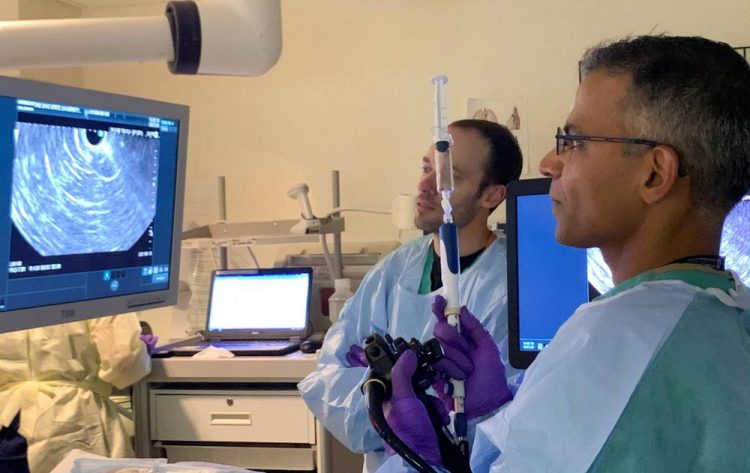'Virtual biopsy' allows doctors to accurately diagnose precancerous pancreatic cysts

Dr. Somashekar Krishna performs an endomicroscopy at The Ohio State University Wexner Medical Center. This new diagnostic method provides doctors with a "virtual biopsy" that allows them to accurately diagnose dangerous pancreatic cysts before they develop into cancer. Credit: The Ohio State University Wexner Medical Center
The current standard involves testing the fluid inside the cysts. It correctly identifies them as benign or precancerous 71% of the time. Researchers found that when the virtual biopsy is added to the standard of care, the diagnostic accuracy jumps to 97%. The study is published in Clinical Gastroenterology and Hepatology and was recently presented at the American Pancreatic Association's Annual Meeting.
“Pancreatic cysts are common, and it can be difficult to distinguish the benign cysts from those destined to become cancerous, but this procedure allows us to do that quickly and with confidence,” said Dr. Somashekar Krishna, a gastroenterologist and lead author of the study.
“We hope that, at the end of the day, we are saving lives either by diagnosing pancreatic cancer early on before it develops into cancer, or we are preventing unnecessary surgery of a benign, harmless pancreatic cyst.”
The diagnostic method tested in the study provides doctors with a microscopic view of the cyst wall, which is produced by a tiny scope that emits laser light inside the cyst. This allows doctors to determine almost immediately if it is precancerous.
“Many times, we are able to tell the patient right after the procedure, 'You have a precancerous cyst, and we need to send you to the surgeon to have it removed',” said Krishna, who is an associate professor in Ohio State's College of Medicine and is also affiliated with The Ohio State University Comprehensive Cancer Center – Arthur G. James Cancer Hospital and Richard J. Solove Research Institute (OSUCCC – James).
A majority of patients get diagnosed with pancreatic cysts incidentally when getting a MRI or CT scan for another reason. Nearly 40% of MRIs done of the abdomen reveal pancreatic cysts and the chance of having them increases with age.
More than 45,000 Americans die of pancreatic cancer each year, making it the third-leading cause of cancer deaths. Patients usually don't have symptoms until the cancer is advanced, making early diagnosis and treatment a challenge.
Ohio State researchers are now working to train doctors at hospitals nationwide to perform this new diagnostic method and read the images provided by the scope to catch dangerous cysts and prevent pancreatic cancer for more patients. They're also working to develop artificial intelligence that will flag cases that are likely precancerous so doctors can act quickly.
Media Contact
Alyssa Moody
alyssa@mediasourcetv.com
614-932-9950
Media Contact
More Information:
http://bit.ly/37BCIIGAll latest news from the category: Medical Engineering
The development of medical equipment, products and technical procedures is characterized by high research and development costs in a variety of fields related to the study of human medicine.
innovations-report provides informative and stimulating reports and articles on topics ranging from imaging processes, cell and tissue techniques, optical techniques, implants, orthopedic aids, clinical and medical office equipment, dialysis systems and x-ray/radiation monitoring devices to endoscopy, ultrasound, surgical techniques, and dental materials.
Newest articles

Properties of new materials for microchips
… can now be measured well. Reseachers of Delft University of Technology demonstrated measuring performance properties of ultrathin silicon membranes. Making ever smaller and more powerful chips requires new ultrathin…

Floating solar’s potential
… to support sustainable development by addressing climate, water, and energy goals holistically. A new study published this week in Nature Energy raises the potential for floating solar photovoltaics (FPV)…

Skyrmions move at record speeds
… a step towards the computing of the future. An international research team led by scientists from the CNRS1 has discovered that the magnetic nanobubbles2 known as skyrmions can be…





















